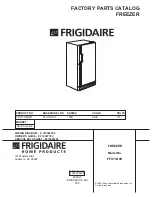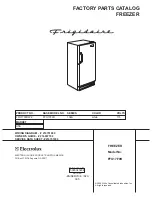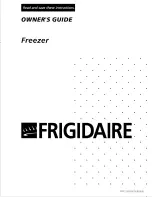
5
Switching on your fridge freezer
1.
Before your fridge freezer is plugged in, open the fridge door and
adjust the thermostat control to the highest setting.
2.
Once the fridge freezer has cooled down, adjust the thermostat
control to a suitable setting.
Adjusting the temperature
To change the internal temperature
of the fridge freezer, use the control
dial located inside the fridge. The
recommended setting is between
3
and
4
for normal use. The fridge freezer may
not operate at the correct temperature if
it is in a particularly hot or cold room or
if you open the doors very often.
Temperature control slider
The temperature control slider is used
to adjust the air flow in the fridge.
With the slider in the UP position, the
volume of cold air is reduced and in the
DOWN position, the volume of cold air is
increased. If you require the food to cool
faster, position the slider in the DOWN
position. For normal operating use, keep
the slider in the middle position.
Is the fridge freezer cold enough?
If you are concerned that your fridge freezer is not being kept cold
enough, and wish to check the temperature, you will need a special fridge
thermometer available from most supermarkets and hardware shops.
Place the thermometer on the middle shelf of the fridge cabinet or the
middle basket of the freezer, where it can be read easily. Leave overnight,
the temperature in the fridge should be between 2˚C and 5˚C and -18˚C
or lower in the freezer. See ‘Adjusting the temperature’.
Where to store your food in the fridge
Cool area
This is where to store foods which will
keep longer if they are kept cool. Milk,
eggs, yogurt, fruit juices, hard cheeses, eg.
cheddar. Opened jars and bottles of salad
dressings, sauces and jams. Fats, eg. butter,
margarine, low-fat spreads, cooking fats
and lard.
Coldest area: 0°C to 5°C
This is where foods which must be cold
to keep them safe should be kept:
• Raw and uncooked foods. These should
always be wrapped.
• Pre-cooked chilled foods, eg. ready meals, meat pies, soft cheeses.
• Pre-cooked meats eg. ham.
• Prepared salads (including pre-washed chopped, pre-packed mixed
green salads, rice, potato salad etc).
• Desserts, eg. fromage frais, home-prepared food and leftovers or
cream cakes.
USING YOUR FRIDGE FREEzER
SALAD BIN
COOLEST
COOL
FREEZING
COOL
Salad bin
This is the most humid part of the fridge. Store vegetables, fruit,
fresh salad items, eg. unwashed whole lettuce, whole tomatoes,
radishes, etc here.
WE RECOMMEND THAT ALL PRODUCE KEPT IN THE SALAD BIN
IS WRAPPED.
NOTE: ALWAYS WRAP AND STORE RAW MEAT, POULTRY AND FISH ON
THE LOWEST SHELF AT THE BOTTOM OF THE FRIDGE. THIS WILL STOP
THEM DRIPPING ONTO, OR TOUCHING OTHER FOODS.
DO NOT STORE INFLAMMABLE GASES OR LIQUIDS IN THE FRIDGE.
Noises inside the fridge freezer
If you have not owned a refrigerator or freezer before, you may notice
that it makes some rather unusual noises. Most of these are perfectly
normal, but you should be aware of them!
Gurgling, whooshing
These noises are caused by the circulation of the refrigerant liquid in the
cooling system. It has become more pronounced since the introduction of
CFC free gases. This is not a fault and will not affect the performance of
your fridge freezer.
Humming, purring or pulsating
This is the compressor motor working, as it pumps the refrigerant around
the system.
Shopping for chilled foods
Don’t buy in your lunch hour!
Unless you have a fridge at work to keep the food cold in the afternoon.
Leaving food in your car or at room temperature for a prolonged period
of time could raise food temperature to the level at which harmful
bacteria grow.
FRIDGE/FREEZER THERMOMETER
°
C
FRIDGE
FREEZER
-30
°
- 20
°
-10
°
0
°
+10
°
+20
°
+30
°
+40
°
USING YOUR FRIDGE FREEzER
TEMPERATURE
CONTROL DIAL
TEMPERATURE
CONTROL SLIDER
Freezer FRC150FF D3.1.indd 5
10/4/08 10:32:46































